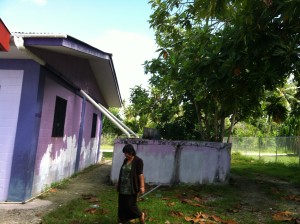The 68,000 people of Marshall Islands are scattered across hundreds of low-lying atoll islets. No place is more than a few hundred meters from the ocean, nor is any spot more than a few meters above sea level. Rainwater catchment is thus the primary – and generally the only – available source of drinking water. The public water supply system in Majuro pumps water from the country’s largest freshwater ‘lens’ in Laura, but does not provide a reliable supply of potable water at all times.
Water for Life is working with the Ministry of Education to upgrade existing catchment systems at all 12 public schools around Majuro. Gutters have been replaced/repaired, screens and/or first-flush diverters installed, leaks fixed, covers replaced, tanks cleaned/repainted, runoff/drainage improved, etc. Thousands of students, as well as teachers, other school staff, and surrounding communities, now enjoy more ready access to cleaner water.
School-based Water Quality Management Teams (WQMTs) are now in place at all schools. These teams of students, teachers, and parents have taken three days of training from RMI EPA staff and now maintain and monitor the schools’ water resources. WQMTs keep roofs and gutters clean, empty first-flush diverters, and assess water quality in school dispensers, reporting their data to RMI EPA monthly.

